The "dialogus" of pseudo-Odo
the first use of Roman letter nominals
modulo A B C D E F G as music notation
Below is a photograph of the section from Chapter 2 which describes (starting at line 6 on the left) the division of the monochord in pythagorean tuning, using the Roman letter nominals A B C D E F G as a modulo-7 system recognizing octave-equivalence for the first time; from the manuscript codex Paris, Bibliothèque Nationale, Fonds Latin 7211, f.107r and 107v.
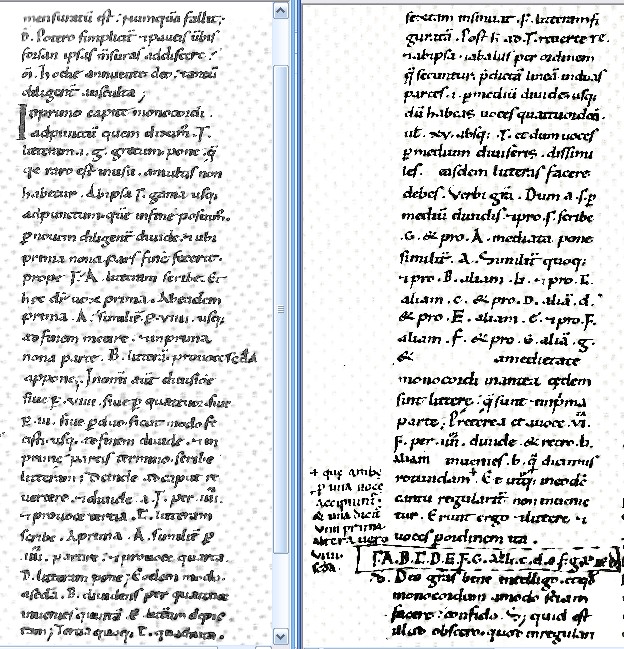
| 2. ET MENSURA | 2. AND MEASUREMENT |
| In primo capite monochordi ad punctum, quem superius diximus, Γ. litteram, id est G. graecum pone, (quae, quoniam raro est in usu, a multis non habetur). | At the first end-piece of the monochord, at the point at which we have spoken above, place the letter Γ, that is, a Greek G. (This Γ, since it is a letter rarely used, is by many not understood.) |
Γ ["nut"] |-----------------------------------------------------| 0 = 1 1 ....................................................|
| Ab ipsa Γ. usque ad punctum, quem in fine posuimus, per novem diligenter divide, et ubi prima nona pars fecerit finem, (prope Γ.) A litteram scribe, et haec dicetur vox prima. | Carefully divide the distance from Γ to the point placed at the other end into nine parts, and where the first ninth from Γ ends, write the letter A; we shall call this the first step. |
Γ ... A |-----|-----|-----|-----|-----|-----|-----|-----|-----| 1 = 8/9 x .. 8/9 .............................................|
| Ab eadem prima littera A. similiter per novem partire usque ad finem, et in nona parte B. litteram pro voce secunda appone. | Then, similarly, divide the distance from the first letter, A, to the end into nine, and at the first ninth, place the letter B for the second step. |
A .. B
|-----|----|----|----|-----|----|----|-----|----|-----| 2 = 8/9 * 8/9
x..64/81 .......................................|
| Dein ad caput revertere, et divide per quatuor a Γ. et pro voce tertia C. litteram scribe. | Then return to the beginning, divide by four from Γ, and for the third step write the letter C. |
Γ ........... C |-------------|------------|------------|-------------| 3 = 3/4 x .......... 3/4 .....................................|
| A prima A. similiter per quatuor divide, et pro voce quarta D. litteram scribe. | From the first letter, A, divide similarly by four, and for the fourth step, write the letter D. |
A ......... D
|-----|-----------|-----------|-----------|-----------| 4 = 8/9 * 3/4
x ........ 2/3 .................................|
| Eodem modo B. dividens per quatuor, invenies quintam E. | In the same way, dividing B by four, you will find the fifth step, E. |
B ....... E
|----------|---------|----------|----------|----------| 5 = 64/81 * 3/4
x ..... 16/27 .............................|
| Tertia quoque C. insinuat sextam litteram F. | The third letter, C, likewise reveals the sixth step, F. |
C ....... F
|-------------|---------|---------|---------|---------| 6 = 3/4 * 3/4
x ...... 9/16 ..........................|
| Post haec ad Γ. revertere, et ab ipsa, et ab aliis, quae sequuntur per ordinem, praedictam lineam in duas partes, id est, per medium divide, usque dum habeas voces quatuordecim vel quindecim absque Γ. | Then return to Γ, and from it and from the other letters that follow it in order, divide the line in two parts, that is, in the middle, until, without Γ, you have fourteen or fifteen steps. |
| et dum voces per medium diviseris, dissimiles easdem facere debebis. Verbi gratia, dum a Γ. per medium dividis, pro Γ. scribe G. pro A. mediata pone a. et pro B. aliam ♮. et pro C. aliam c. et pro D. aliam d. et pro E. aliam e. et pro F. aliam f. et pro G. aliam g. pro a aliam aa ut a medietate monochordi in antea eaedem sint litterae, quae sunt et in prima parte. | When you divide the sounds in the middle, you must mark them differently. For example, when you bisect the distance from Γ, instead of Γ, write G; for A bisected, set down a second a; for B, a second ♮ ; for C, a second c; for D, a second d, for E, a second e; for F, a second f; for G, a second g; and for a, a second aa; so that from the middle of the monochord forward, the letters will be the same as in the first part. |
Γ ........................ G
|--------------------------|--------------------------| 7 = 1/2
x ....................... 1/2 ........................|
A .................... a
.|-----|----------------------|------------------------| 8 = 8/9 * 1/2
x ................... 4/9 ......................|
B ................. ♮
|----------|--------------------|---------------------| 9.2 = 64/81 * 1/2
x ................ 32/81 ..................|
C ................ c
|-------------|------------------|--------------------| 10 = 3/4 * 1/2
x ............... 3/8 ..................|
D .............. d
|-----------------|----------------|------------------| 11 = 2/3 * 1/2
x ............. 1/3 ................|
E .............. e
|--------------------|----------------|---------------| 12 = 16/27 * 1/2
x ............. 8/27 ............|
F ............ f
|-----------------------|--------------|--------------| 13 = 9/16 * 1/2
x ........... 9/32 ...........|
G ........... g
|--------------------------|-------------|------------| 14 = 1/2 * 1/2
x .......... 1/4 ..........|
a .......... aa
|----------------------------|------------|-----------| 15 = 4/9 * 1/2
x ......... 2/9 .........|
| Praeterea a voce sexta F. per quatuor divide, et retro ♮. aliam b. rotundam pone: quae ambae pro una voce accipiuntur, et una dicitur nona secunda, et utraque in eodem cantu regulariter non invenietur. | In addition, from the sixth step, F, divide into four, and before ♮ , place a second round b; these two are accepted as a single step, one being called the second ninth step, and both are not regularly found in the same melody. |
F .... b
|-----------------------|------|-------|------|-------| 9.1 = 9/16 * 3/4
x .. 27/64 ...................|
| Figurae autem et voces et litterae per ordinem ita ponuntur. Γ. I. A. II. B. III. C. IIII. D. V. E. VI. F. VII. G. VIII. a. IX. I. b. IX. II. ♮. X. c. XI. d. XII. e. XIII. f. XIIII. g. XV aa. | The figures, moreover, both sounds and letters, are thus arranged in order: |
Γ A B C D E F G a b ♮ c d e f g aa = notes 0 1 2 3 4 5 6 7 8 9.1 9.2 10 11 12 13 14 15 = steps
The complete division, with "both 9th steps" in pitch order, is shown thus:
complete division:
Γ ["nut"]
|-----------------------------------------------------| 0 = 1
1 ....................................................|
Γ ... A
|-----|-----|-----|-----|-----|-----|-----|-----|-----| 1 = 8/9
x .. 8/9 .............................................|
A .. B
|-----|----|----|----|-----|----|----|-----|----|-----| 2 = 8/9 * 8/9
x..64/81 .......................................|
Γ ........... C
|-------------|------------|------------|-------------| 3 = 3/4
x .......... 3/4 .....................................|
A ......... D
|-----|-----------|-----------|-----------|-----------| 4 = 8/9 * 3/4
x ........ 2/3 .................................|
B ....... E
|----------|---------|----------|----------|----------| 5 = 64/81 * 3/4
x ..... 16/27 .............................|
C ....... F
|-------------|---------|---------|---------|---------| 6 = 3/4 * 3/4
x ...... 9/16 ..........................|
Γ ........................ G
|--------------------------|--------------------------| 7 = 1/2
x ....................... 1/2 ........................|
A .................... a
.|-----|----------------------|------------------------| 8 = 8/9 * 1/2
x ................... 4/9 ......................|
F .... b
|-----------------------|------|-------|------|-------| 9.1 = 9/16 * 3/4
x .. 27/64 ...................|
B ................. ♮
|----------|--------------------|---------------------| 9.2 = 64/81 * 1/2
x ................ 32/81 ..................|
C ................ c
|-------------|------------------|--------------------| 10 = 3/4 * 1/2
x ............... 3/8 ..................|
D .............. d
|-----------------|----------------|------------------| 11 = 2/3 * 1/2
x ............. 1/3 ................|
E .............. e
|--------------------|----------------|---------------| 12 = 16/27 * 1/2
x ............. 8/27 ............|
F ............ f
|-----------------------|--------------|--------------| 13 = 9/16 * 1/2
x ........... 9/32 ...........|
G ........... g
|--------------------------|-------------|------------| 14 = 1/2 * 1/2
x .......... 1/4 ..........|
a .......... aa
|----------------------------|------------|-----------| 15 = 4/9 * 1/2
x ......... 2/9 .........|
To obtain integer numbers for all divisions, the smallest number for the entire string (Γ) must be 5184. The divisions are given thus:
Γ 5184 A 4608 B 4096 C 3888 D 3456 E 3072 F 2916 G 2592 a 2304 b 2187 ♮ 2048 c 1944 d 1728 e 1536 f 1458 g 1296 aa 1152
Below is a lattice-diagram of this system:
pseduo-Odo _dialogus_, c.1000 AD
first use of modulo-7 A B C D E F G nominals in music notation
lattice in 2,3-space
top row is 2,3-monzo
second row is letter notation
third row is ratio
fourth row is step number
[2 0> [-1 2>
g ------------ aa
4:1 | 9:2
14 | 15
| | |
| | |
[6 -3> [5 -2> [3 -1> [1 0> [0 1> [-2 2> [-3 3> [-5 4>
b ----- f ----- c ----- G ----- d ----- a ----- e ----- ♮
64:27 32:9 8:3 2:1 3:1 9:4 27:8 81:32
9.1 13 10 7 11 8 12 9.2
| | | | | | |
| | | | | | |
[4 -2> [2 -1> [0 0> [-1 1> [-3 2> [-4 3> [-6 4>
F ----- C ----- Γ ----- D ----- A ----- E ----- B
16:9 4:3 1:1 3:2 9:8 27:16 81:64
6 3 0 4 1 5 2
| 4. DE CONSONANTII | 4. OF THE CONSONANTS |
| Tres sunt praeter tonum divisiones, quae naturalem vocum, quam supra dixi, positionem custodiunt. | Besides the division of the tone, there are three divisions which govern the natural position of sounds which I have mentioned above. |
| Prima quaternaria est, propter quod in quatuor divisa est, ut a prima A. in quartam D. et haec habet voces quatuor, intervalla tria, id est, duos tonos et unum semitonium. | The first is the quaternary division, as from the first step, A, to the fourth, D, so called because it is a division by four; this has four pitches and three intervals, namely, two tones and one semitone. |
| Ubicumque ergo in monochordo inter duas voces duos tonos, et unum semitonium invenies, ipsarum duarum vocum intervallum quaternaria divisione currere ad finem usque probabis: et ideo diatessaron, id est, de quatuor nomen accepit. | Therefore, wherever you find two tones and a semitone between two pitches on the monochord, you will discover on trial that the interval formed by these two pitches extends to the very end in quaternary division; for this reason it is called diatessaron, that is, "of four". |
| Secunda vero ternaria est, ut a prima voce A. in quintam E. in cuius spatio continentur voces quinque, intervalla quatuor, id est, tres toni et unum semitonium. | The second is the ternary division, as from the first step, A, to the fifth, E, this contains five pitches and four intervals, namely, three tones and one semitone. |
| Ubicumque ergo videris inter duas voces tres tonos et unum semitonium, ipsarum vocum spatium ternis ad finem passibus currit. | Therefore, wherever you see three tones and one semitone between two pitches, the interval formed by these two pitches will extend to the end by successive divisions of one-third. |
| Vocatur autem diapente, id est, de quinque, eoquod voces sunt in eius spatio quinque. | This interval is called diapente, that is, "of five", because it encloses five pitches. |
| Tertia vero divisio est, quae per duo vel per medium dividitur, et dicitur diapason, id est, de omnibus. | The third is what is divided by two, or in the middle; it is called diapason, that is, "of all". |
| Hanc, ut supra dictum est, ex litterarum similitudine patenter agnoscis, ut a prima A. in octavam a. | This, as was said above, you will plainly recognize from the likeness of the letters, as from the first step, A, to the eighth, a. |
| Constat autem vocibus octo, intervallis septem, id est, tonis quinque, semitoniis duobus. | It consists of eight pitches and seven intervals, namely, of five tones and two semitones, ... |
| Continet etiam unum diatessaron et unum diapente. A prima A. in quartam D. fit diatessaron, et a quarta D. in octavam a. diapente: | ... for it contains one diatessaron and one diapente, the interval from the first step, A, to the fourth, D, forming a diatessaron, that from the fourth step, D, to the eighth, a, forming a diapente. |
| a prima A. in octavam a. diapason invenitur hoc modo: A. B. C. D. E. F. G. a. | From the first step, A, to the eighth, a, the diapason is obtained in the following manner: A, B, C, D, E, F, G, a. |
Below are the 8 main modes:
pseudo-Odo "dialogus": Mode I on D
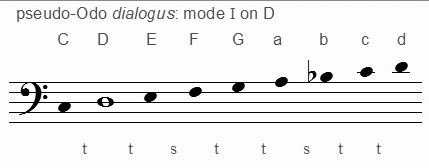
pseudo-Odo "dialogus": Mode II on D
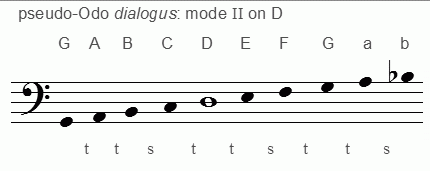
pseudo-Odo "dialogus": Mode III on E
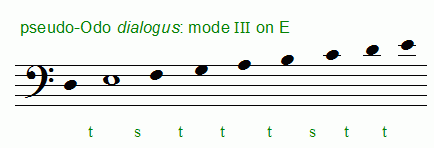
pseudo-Odo "dialogus": Mode IV on E
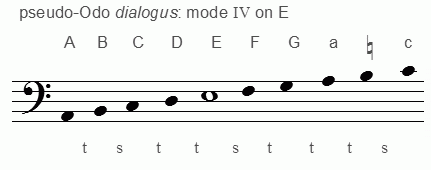
pseudo-Odo "dialogus": Mode V on F
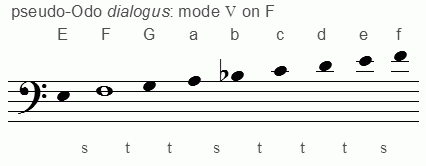
pseudo-Odo "dialogus": Mode VI on F
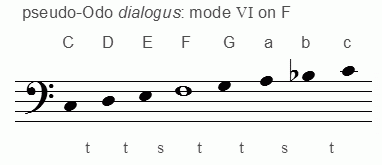
pseudo-Odo "dialogus": Mode VII on G
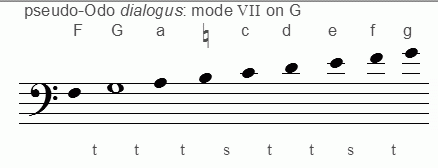
pseudo-Odo "dialogus": Mode VIII on G
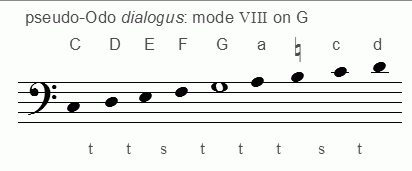
Below are all the auxilliary modes which pseudo-Odo shows with finals on all othe r notes in the system:
pseudo-Odo "dialogus": Mode I on A
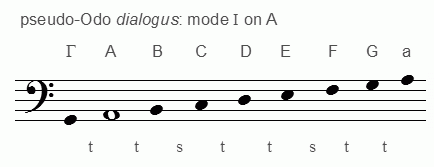
pseudo-Odo "dialogus": Mode I on a
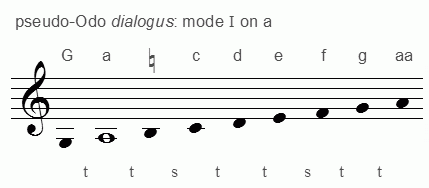
pseudo-Odo "dialogus": Mode I on d
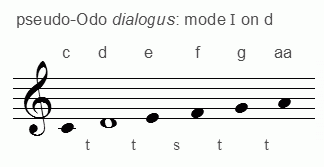
pseudo-Odo "dialogus": Mode I on aa
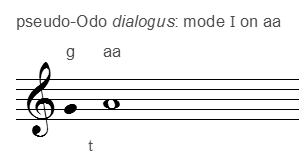
pseudo-Odo "dialogus": Mode II on A

pseudo-Odo "dialogus": Mode II on a

pseudo-Odo "dialogus": Mode II on d

pseudo-Odo "dialogus": Mode II on aa

pseudo-Odo "dialogus": Mode III on a

pseudo-Odo "dialogus": Mode III on e

pseudo-Odo "dialogus": Mode IV on B
pseudo-Odo "dialogus": Mode IV on square-b

pseudo-Odo "dialogus": Mode IV on e

pseudo-Odo "dialogus": Mode V on C
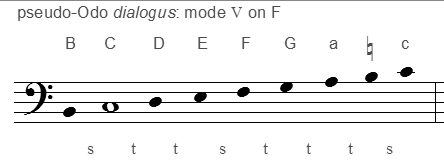
pseudo-Odo "dialogus": Mode V on c

pseudo-Odo "dialogus": Mode V on f

pseudo-Odo "dialogus": Mode VI on C

pseudo-Odo "dialogus": Mode VI on c

pseudo-Odo "dialogus": Mode VI on f

pseudo-Odo "dialogus": Mode VII on Γ

pseudo-Odo "dialogus": Mode VII on g

pseudo-Odo "dialogus": Mode VIII on Γ

pseudo-Odo "dialogus": Mode VIII on c
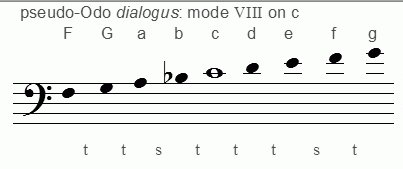
pseudo-Odo "dialogus": Mode VIII on g

REFERENCES
pseudo-Odo
Dialogus
Scriptores ecclesiastici de musica sacra potissimum, 3 vols.
ed. Martin Gerbert
St. Blaise: Typis San-Blasianis, 1784
reprint ed., Hildesheim: Olms, 1963
1:251-64
www.chmtl.indiana.edu/tml/9th-11th/ODODIA_TEXT.html
pseudo-Odo
Dialogus
Patrologia cursus completus, series latina, 221 vols.
ed. J. P. Migne
Paris: Garnier, 1844-1904
133:757-74
www.chmtl.indiana.edu/tml/9th-11th/ODODI_TEXT.html
